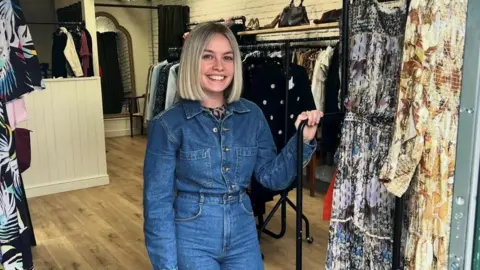How my challenge to stop buying new clothes has gone
 BBC
BBCLast New Year’s Eve, I set myself the challenge of not buying any brand new clothes for a whole year.
I did this because I was worried about the link between fast fashion and the environment.
Growing popularity of resale sites including Vinted, which reported over 500 million listings on its site, and Depop (more than 34 million listings) have led me to review my shopping habits.
I realised there are enough clothes already in circulation to sustain us for generations.
Ginger Zee, chief meteorologist at ABC News in New York, inspired me to take on the "no new clothes challenge" and has not bought any new clothes since June 2022.
Ms Zee said: "This combination of the social responsibility of thinking about where our clothing comes from, who touches it, how many places it goes before it gets to us, and the marketing of it has changed so rapidly right under our noses.
"I never want to sound like I want fashion to end, because I think it's really important. But the way we're doing it right now globally for the most part is not good."
She added taking "a beat and a pause" to think about consumption and fashion was important.

To appear on television I supply my own clothes and I choose what to wear, so there has always been a temptation to freshen up my wardrobe and create new looks.
I was all too familiar with fast fashion and would spend hundreds of pounds on clothes each year.
Over the past 11 months, I have only purchased a small number of items from charity shops, second-hand stores or on resale sites – with the exception of shoes and underwear.
I have developed a love for decluttering – I have made it my mission to donate and sell the items in my wardrobe I no longer need to avoid them ending up in landfill.
I have also learnt new skills. My mum has been teaching me how to sew and it means I have given some of my clothes a new lease of life.
Since I have started this challenge, I have borrowed my mum's clothes - like her skirt from the 1980s - and my auntie has passed on dresses that no longer suit her.

Clothes swapping events are becoming more popular, particularly among students and young people.
I went to one in Cardiff organised by youth climate and peace ambassadors, where I donated five items and picked up a jacket and a skirt. They also had a catwalk show, modelling clothes they had made and upcycled.
It was really refreshing to speak to such a motivated group of young women, including Menna and Yolay, who understand the importance of supporting sustainable fashion.
Menna said: "I know I have lots of clothes at home that are amazing quality. They're really nice, but I just don't wear them enough. So we thought if we do a clothes swap. It gives new life to clothing items."
Yolay said: "I think a big thing as well is, you don't see a lot of clothes swaps in Wales and I think we definitely wanted to bring one to Cardiff.
"I just think sustainable clothing is the new way forward. It's financially cheaper and it's also more rewarding to be able to say I found this piece and it's sustainable."
 Jessica Renault
Jessica RenaultI also visited pre-loved boutiques like Déjà Vu in Cardiff.
Owner Jessica Renault, 27, says she thinks there is still quite a way to go when it comes to people’s attitudes and shopping habits with all fashion, but particularly pre-loved items.
"I think it’s about being more considerate, so actually thinking about what you buy before you buy it and not always buying something because it’s on trend," she said.
The most important tip is to focus on the quality of the fabric above the brand and the label, she said.
"If you’re buying things, then the fabric is important because it means you’re going to get more wear out of it.
"From a selling point of view it’s going to be beneficial because when you go to sell it, it’s going to be in better condition so you’re going to get more money for it."

This year I have transformed my relationship with fashion and really learnt how to embrace circular fashion. I know I will never go back to buying everything brand new.
I know I am not able to make much of a difference alone, but I hope I can inspire others to learn more about sustainable fashion.
I would be lying if I said I have not missed a shopping spree and I cannot deny the pressure I feel from social media to keep up with the rest of the world.
But this year has taught me that trends come back around and if you are creative, you can keep up with all the fashionistas of the world – all while looking after the planet.
